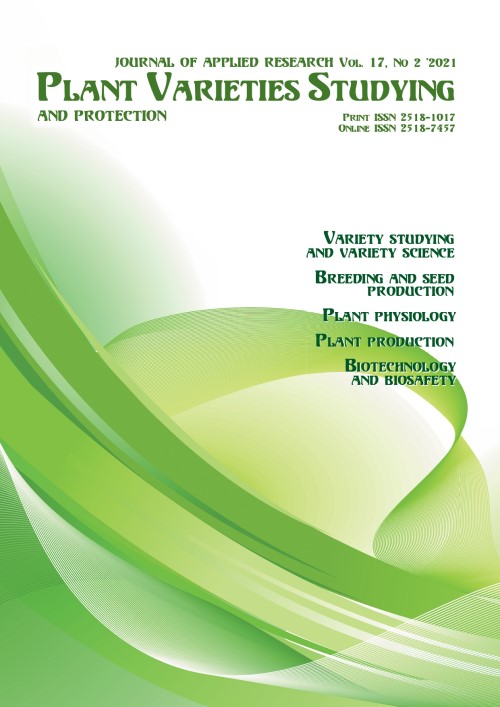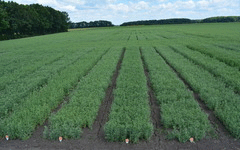Sampling for vegetative propagation: A phytosanitary status survey of grapevines collection by One Step RT-PCR method
DOI:
https://doi.org/10.21498/2518-1017.17.2.2021.236525Keywords:
one step RT-PCR, RNA extraction, grapevine varieties, GLRaV3, GFLV, vegetative propagationAbstract
Purpose. Grapevines (Vitis spp.) are affected by many viral diseases which cause serious pathological problems. GLRaV-3 is among the most widespread leafroll viruses, while Grapevine Fanleaf Virus (GFLV) is a destructive pathogen which reduces the lifespan of grapevine. Considering the impact and the spread of these diseases, our objective was to analyse the presence of these two viruses in several grapevine varieties in grapevine collection at ATTC Vlore. Data gathered from plant pathogens serve to better understand and prevent the spread of pathogens, as a mandatory rule for the quality control of certified plant material during vegetative propagation.
Method. The presence of two common viruses were tested using virus specific primers; LC1/LC2 primer pair designed from the hHSP70 gene for detecting Grapevine Leafroll-associated Virus-3 (GLRaV3) and C3390/H2999 primer pair, designed from coat protein coding regions for detecting Grapevine Fanleaf Virus (GFLV), in six varieties; ‘Merlot’, ‘Kallmet’, ‘Shesh i zi’, ‘Shesh i bardhё’, ‘Debinё’, and ‘Pulёz’, provided through a randomised sampling procedure. One Step Reverse Transcription Polymerase Chain Reaction assay was used to detect the viral presence.
Results showed a high (100%) prevalence of GLRaV3 virus in all of analysed samples, as the most frequent among the two pathogens. Analysis for of GFLV virus showed low infection rate, being present in only one sample.
Conclusions. We herein show an efficient, fast and reproducible method for detecting grapevine viruses through one step RT-PCR. Our results suggest that sampling of the infected plant material should be avoided due to the presence of viral infections.
Downloads
References
Armijo, G., Schlechter, R., Agurto, M., Muñoz, D., Nuñez, C., & Arce-Johnson, P. (2016). Grapevine Pathogenic Microorganisms: Understanding Infection Strategies and Host Response Scenarios. Front. Plant Sci., 7, 382. doi:10.3389/fpls.2016.00382
Chaparro-Encinas, L. A., Arellano-Wattenbarger, G. L., Parra-Cota, F. I., & de los Santos-Villalobos, S. (2020). A modified CTAB and Trizol® protocol for high-quality RNA extraction from whole wheat seedlings, including rhizosphere. Cereal Res. Commun., 48(3), 275–282. doi: 10.1007/s42976-020-00046-9
Pathogen-tested material of grapevine varieties and rootstocks. (2008). EPPO Bulletin, 38(3), 422–429. doi: 10.1111/j.1365-2338.2008.01258.x
Gambino, G., Perrone, I., & Gribaudo, I. (2008). A rapid and effective method for RNA extraction from different tissues of grapevine and other woody plants. Phytochem. Anal., 19(6), 520–525. doi: 10.1002/pca.1078
Garcia, S., Hily, J., Komar, V., Gertz, C., Demangeat, G., Lemaire, O., & Vigne, E. (2019). Detection of Multiple Variants of Grapevine Fanleaf Virus in Single Xiphinema index Nematodes. Viruses, 11(12), 1139. doi:10.3390/v11121139
Golino, D. A., Fuchs, M., Al Rwahnih, M., Farrar, K., Schmidt, A., & Martelli, G. P. (2017). Regulatory Aspects of Grape Viruses and Virus Diseases: Certification, Quarantine, and Harmonization. In B. Meng, G. Martelli, D. Golino, & M. Fuchs (Eds.), Grapevine Viruses: Molecular Biology, Diagnostics and Management (pp. 581–598). Springer Int. Publ. doi: 10.1007/978-3-319-57706-7_28
Hančević, K., Saldarelli, P., Čarija, M., Černi, S., Zdunić, G., Mucalo, A., & Radić, T. (2021). Predominance and Diversity of GLRaV-3 in Native Vines of Mediterranean Croatia. Plants, 10(1), 17. doi: 10.3390/plants10010017
Invitrogen, TRIzol reagent. Retrieved from http://tools.thermofisher.com/content/sfs/manuals/trizol_reagent.pdf
Jordon-Thaden, I. E., Chanderbali, A. S., Gitzendanner, M. A., & Soltis, D. E. (2015). Modified CTAB and TRIzol protocols improve RNA extraction from chemically complex Embryophyta. Appl. Plant Sci., 3(5), 1400105. doi: 10.3732/apps.1400105
Lacroix, C., Renner, K., Cole, E., Seabloom, E. W., Borer, E. T., & Malmstrom, C. M. (2016). Methodological Guidelines for Accurate Detection of Viruses in Wild Plant Species. Appl. Environ. Microbiol., 82(6), 1966–1975. doi: 10.1128/AEM.03538-15
Ling, Z., Zhike, Z., Shunquan, L., Tingting, Z., & Xianghui, Y. (2013). Evaluation of Six Methods for Extraction of Total RNA from Loquat. Not. Bot. Horti Agrobot. Cluj Napoca, 41(1), 313–316. doi: 10.15835/nbha4118233
MacKenzie, D. J., McLean, M. A., Mukerij, S., & Green, M. (1997). Improved RNA extraction from woody plants for the detection of viral pathogens by reverse transcriptase-polymerase chain reaction. Plant Disease, 81(2), 222–226. doi: 10.1094/PDIS.1997.81.2.222
Maliogka, V. I., Martelli, G. P., Fuchs, M., & Katis, N. I. (2015). Control of Viruses Infecting Grapevine. In Advances in Virus Research (pp. 175–227). Elsevier. doi: 10.1016/bs.aivir.2014.11.002
Merkuri, J., Martelli, G. P., Boscia, D., & Savino, V. (1994). Viruses of grapevine in Albania. EPPO Bulletin, 24(1), 215–220. doi: 10.1111/j.1365-2338.1994.tb01062.x
Minafra, A., & Hadidi, A. (1994). Sensitive detection of grapevine virus A, B, or leafroll-associated III from viruliferous mealybugs and infected tissue by cDNA amplification. J. Virol. Methods, 47(1–2), 175–187. doi: 10.1016/0166-0934(94)90076-0
Montero, R., El aou ouad, H., Flexas, J., & Bota, J. (2016). Effects of grapevine leafroll associated virus 3 (GLRaV-3) on plant carbon balance in Vitis vinifera L. cv. Giró Ros. Theor. Exp. Plant Physiol., 28(1), 1–10. doi: 10.1007/s40626-015-0050-6
Osman, F., & Rowhani, A. (2006) Application of a spotting sample preparation technique for the detection of pathogens in woody plants by RT-PCR and real-time PCR (TaqMan). J. Virol. Methods, 133(2), 130–136. doi: 10.1016/j.jviromet.2005.11.005
Pallás, V, Sánchez-Navarro, J. A., & James, D. (2018). Recent Advances on the Multiplex Molecular Detection of Plant Viruses and Viroids. Front. Microbiol., 9, 2087. doi: 10.3389/fmicb.2018.02087
Ragozzino, E., Faggioli, F., & Barba, M. (2004). Development of a one tube-one step RT-PCR protocol for the detection of seven viroids in four genera: Apscaviroid, Hostuviroid, Pelamoviroid and Pospiviroid. J. Virol. Methods, 121(1), 25–29. doi: 10.1016/j.jviromet.2004.05.012
Sadikaj, D., Cara, M., & Merkuri, J. (2016). Phytosanitary Status of Some Albanian Grapevine Varieties with Reference to main Viral Diseases. Albanian J. Agric. Sci., Special Ed., 49–52.
Turturo, C., Saldarelli, P., Yafeng, D., Digiaro, M., Minafra, A., Savino, V., & Martelli, G. P. (2005). Genetic variability and population structure of Grapevine leafroll-associated virus 3 isolates. J. Gen. Virol., 86(1), 217–224. doi: 10.1099/vir.0.80395-0
Ulea, E., Irimia, N., & Lipşa, F. D. (2012). Serological detection of Grapevine fanleaf virus (GFLV) in ampelographic collection from USAMV Iaşi (Romania). Res. J. Agric. Sci., 44(2), 108–111.
Yadav, N., & Khurana, S. M. P. (2016). Plant Virus Detection and Diagnosis: Progress and Challenges. In Frontier Discoveries and Innovations in Interdisciplinary Microbiology (pp. 97–132). Springer India. doi: 10.1007/978-81-322-2610-9_7
Youssef, S. A., Moawed, S. M., El-Sayed, M., & Shalaby, A. A. (2010). Detection of olive tree viruses in Egypt by one-step RT-PCR. Julius-Kühn-Archiv, 427: 21st International Conference on Virus and other Graft Transmissible Diseases of Fruit Crops, 51–52. Retrieved from https://ojs.openagrar.de/index.php/JKA/article/view
Downloads
Accepted by editor
Published
How to Cite
Issue
Section
License
Copyright (c) 2021 Ukrainian Institute for Plant Variety Examination

This work is licensed under a Creative Commons Attribution-ShareAlike 4.0 International License.
Starting in 2022, the copyright to the publication remains with the authors
Our journal abides by the CREATIVE COMMONS copyright rights and permissions for open access journals.
Authors, who are published in this journal, agree to the following conditions:
- The authors reserve the right to authorship of the work and pass the first publication right of this work to the journal under the terms of a Creative Commons Attribution License, which allows others to freely distribute the published research with the obligatory reference to the authors of the original work and the first publication of the work in this journal.
- The authors have the right to conclude separate supplement agreements that relate to non-exclusive work distribution in the form in which it has been published by the journal (for example, to upload the work to the online storage of the journal or publish it as part of a monograph), provided that the reference to the first publication of the work in this journal is included.

























 Ukrainian Institute for Plant Varieties Examination
Ukrainian Institute for Plant Varieties Examination  Селекційно-генетичний інститут
Селекційно-генетичний інститут Institute of Plant Physiology and Genetics of the National Academy of Sciences of Ukraine
Institute of Plant Physiology and Genetics of the National Academy of Sciences of Ukraine
 The National Academy of Agrarian Sciences of Ukraine
The National Academy of Agrarian Sciences of Ukraine